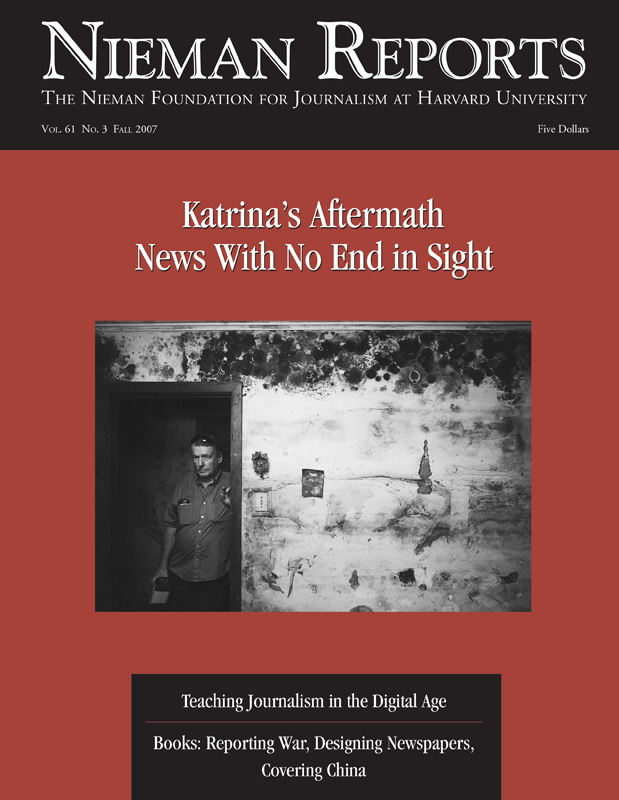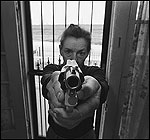I had been living in the destroyed city of New Orleans for nine months when a colleague gave me the following piece of advice: “Make them smell it.” He wasn’t giving me advice on how to write about the city, although he should have been. His comment came in response to a casual question on where I should take first-time visitors to New Orleans. “Don’t just drive by the flooded houses,” he said. “Stop the car. Make them get out. Make sure they smell it.”
By then, I had become accustomed to the smell of the mold-infested walls. Nine months of fresh air had washed over them, diminishing the initial hit. Like the smell, so too the images of destruction had stopped hitting me as they had in my first months there, and I found myself reaching for tired phrases to describe the environment around me. Do a Google search on New Orleans, and you will find writer after writer reflexively describing the city as “hurricane ravaged,” “hurricane scarred,” or “storm battered” and “storm scarred.” They describe the number of feet of water that swept into each house and make note of “piles of debris” on the street outside.
All of us had become accustomed to the homes yanked off their foundations and the perpetual deteriorating state of these properties. With this familiarity, a lot of us had stopped describing well what we were actually seeing and hearing and smelling. So I began deliberately to note the kind of details I might otherwise have ignored — the color of the warped wallpaper, of stiff clothes and bloated mattresses. I jotted in my notebook the size of measuring cups scattered on a flooded kitchen floor. I sketched the shape of the blades of a ceiling fan, hanging downwards like the petals of a drooping flower, the result of gushing water. I copied the smudged words on a sheet of music, the words underlined in a swollen textbook, and the chapter and verse still highlighted in a mold-caked Bible. I took note of the brand of toothpaste and of dishwashing liquid. I returned on second and third trips to the same house to fill in my notes, realizing I had written Crest, but not the flavor or Dove, but not the color.
Almost none of this information made it into my stories, but it became an exercise in looking closely. In that act of looking, I tripped over details that illuminated the destroyed lives of people I wrote about. To write a story on the impact of the storm on children I traversed the city looking for flooded toys. I found a teddy bear, his fur matted with mud. A headless stuffed rabbit poked out of the rubble of a ruined house. In another heap, I found a baby doll, her arms raised above her head as if waiting to be picked up. I filled half a notebook with detailed descriptions of toys and from it distilled a paragraph that became a key section of my story and a metaphor for what the hurricane had done to children’s lives.
What I’d recorded in my notebooks also informed how I interviewed children. I asked them to tell me what toy they missed most from their destroyed room. Then I asked them to tell me what, if anything, they had been able to salvage. For eight-year-old Gabrielle Riley, that was a large, floppy-eared rabbit that her mother had given her. Gabrielle’s mother died of pneumonia during the storm, and the rabbit, propped up on her bunk bed in the family’s new home, opened the way for her to tell me about how she is afraid of losing the rest of her family. Since the hurricane, whenever her dad takes a nap, she stands outside his room on edge. When she hears nothing she peeks in, trying to see if the covers are moving up and down with his breath. Eventually she yells out, “Daddy, are you OK?”
In journalism, we often speak of gathering “color” for a story, as if it’s separate from the substance of the article, a frivolous addition like a pretty border around a painting. I chafe at that. Details are like spotlights, pointing out an aspect of a person’s life or a moment in time in a city’s recovery.
When I first arrived in New Orleans, it had already been one and a half months since the storm. I was one of dozens of reporters parachuted in for a 10-day stint — breathless at the chance to cover a big story. On my way there, my suitcase had been given a “Heavy” tag at the airport, weighed down by hip waders, rubber boots, goggles and an industrial-strength respirator, accouterments I thought I needed to ford a flooded city. I found the water gone but the devastation vast, immeasurable and shocking.
In my rental car, I left the French Quarter one night and drove into the skeleton of the destroyed city. It was only a short distance to travel, perhaps a few blocks, but I arrived in a darkness so deep that my headlights became the only source of light. The hulls of dead houses passed me one after another. I rolled down my window and felt the dead air, pregnant with mold.
Months later, I would drive past the same houses, but they no longer smelled from the street. It would take walking inside to remind myself of the stench. Some of the houses had been gutted. Families that could afford to pulled out the rotten wallboard, installing new roofs, drywall and flooring. Neighborhoods began to look like a patchwork quilt, a repaired house with a green lawn flanking an abandoned one, where weeds had overtaken the mailbox.
It was this halfway-there state that I found difficult to capture. I struggled to describe a city that was suffering on the one hand but a model of resilience on the other. To capture the passage of time, I used the details of people’s daily lives.
Eighty percent of New Orleans flooded when the city’s aging levees collapsed under the weight of the swelling water. Yet only the neighborhoods closest to the broken barriers flooded up to the roofline. Many more homes swallowed just a few feet of water, enough to destroy the first story, but not the second. On one of my first drives through the city at night, I noticed that high above the street the darkness was interrupted by the flicker of a candlelight, or the intermittent beam of a flashlight.
Those points of light were among the first signs of life in a city some had given up for dead. Tired of hotels or of imposing on relatives, homeowners who had two-story homes had begun returning, boldly moving into their dry upstairs, even if the bottom half of their home was still sloshing with water. A doctor who had swum out of his flooded house balancing his parrot’s cage on a floating tire was the first person back on his block. I found him by driving up and down the block until I saw the flash of light — the beam off his headlamp. He invited me upstairs and guided me up the staircase with the light propped on his forehead. On a Coleman stove, he boiled water and made me a cup of coffee.
We talked about the ways in which our daily rituals are tied to the first, not the second-story. A house’s electric meter is typically located on the ground floor, so even if the upstairs is dry, the home’s electrical input has been flooded. Without electricity, the young doctor relied on flashlights and kerosene lanterns. Down the street, a young woman lit candles in each room, placing them in deep, globular bowls to catch the wax.
In my notebook, I made a list of all the things I do from morning to night — and then went through the list with each family to see what aspects of their day had changed. Kitchens, like electrical meters, are usually located downstairs. Living upstairs, the families devised new ways to cook. They washed their vegetables in the bathtub and cooked dinner on a barbecue stove placed on the second-story balcony. One mother of three told me that she got tired of making a mess in the bathroom, so she took to washing her dishes in the yard using the garden hose. She combed the local grocery store for ready-to-eat ingredients, like prewashed lettuce and packets of broccoli florets. Soon she switched to paper plates and plastic forks.
As the city began to heal, I visited these same neighborhoods, marking progress in terms of a family’s ability to have a hot rather than a cold shower, a microwaved rather than a barbecued dinner, and electricity rather than battery-powered light. The shift never came all at once, but in bite-sized chunks. I found the timeline of the city’s renaissance in mundane details and in revealing what daily rituals were still altered.
Nearly a year had passed since the storm when I knocked on the door of an elegant Victorian that from the outside appeared repaired. The elderly man who opened the door refused to show himself, cracking the door open a few inches and speaking loudly across the divide. He told me that the city could be divided into two kinds of people: “Those that came back and those that came back, threw up their hands and gave up.”
He was one of the people who hadn’t given up, dragging the sopping furniture to the curb, yanking out the mottled floorboards, and pouring his savings into construction materials. His house was — almost — as good as new. But why wouldn’t he show himself? He told me that in spite of repeated visits to city hall to get an electricity permit, he had so far failed to receive one and restore power to his house. It was summer and, to get some respite from the oven-like heat, he had taken to moving around his house naked, carrying a battery-operated fan from room to room.
Details — color — are the lifeblood of stories, especially those drawn out over long arcs of time.
Rukmini Callimachi worked in New Orleans as a reporter with The Associated Press in the aftermath of Hurricane Katrina.



